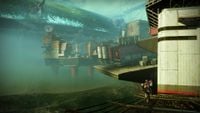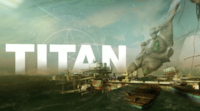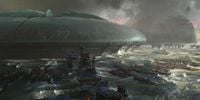Titan (moon): Difference between revisions
From Destinypedia, the Destiny wiki
No edit summary |
|||
| Line 47: | Line 47: | ||
*Some of the structures on Titan have names, such as "Kemphaan" and "Poelruiter". These are Dutch birds that usually live in wet areas, suggesting that some of the first people on Titan were Dutch. This could also be a reference to the fact that the Dutch are famous for dealing with water, or in this case, the oceans of Titan. | *Some of the structures on Titan have names, such as "Kemphaan" and "Poelruiter". These are Dutch birds that usually live in wet areas, suggesting that some of the first people on Titan were Dutch. This could also be a reference to the fact that the Dutch are famous for dealing with water, or in this case, the oceans of Titan. | ||
*The [[Hive]] are exclusively present on Titan in ''[[Destiny 2]]''. | *The [[Hive]] are exclusively present on Titan in ''[[Destiny 2]]''. | ||
==Gallery== | ==Gallery== | ||
| Line 60: | Line 56: | ||
titan arcology concept art.jpg|Concept art | titan arcology concept art.jpg|Concept art | ||
</gallery> | </gallery> | ||
==List of appearances== | |||
*''[[Destiny]]'' {{1st}} | |||
*''[[Destiny 2]]'' | |||
==Notes== | ==Notes== | ||
Revision as of 22:49, September 18, 2017
This article has new content coming soon from Destiny 2 and may not be complete, confirmed, or correct. Please update it as soon as any relevant and accurate material is available. Editors must cite sources for all contributions to this article. Edits that do not follow this standard will be reverted without notice. For more information, see the Citation policy.
| Titan | |
|---|---|

| |
| Astrographical | |
|
Star, position: |
|
| Physical | |
|
Diameter: |
5,150 kilometers |
|
Gravity: |
.14 g |
|
Length of day: |
15.94 days (synchronous) |
|
Atmosphere: |
|
|
Surface temperature: |
−179.2 °C |
| Societal | |
|
Population: |
|
|
Government: |
Hive and House of Dusk Occupation |
- "The great monuments of mankind's utopian Golden Age now lie toppled or half submerged within the rolling ocean that blankets the entire surface of Titan. All that remains is a flotilla of construction barges and a lone human habitat that serves as the perfect hiding place for some of humanity's scattered forces — and some far more sinister below"
- — Website description
Titan is the largest moon of Saturn.[1] One of the legends of the Nine states that they are ancient leviathan intelligences originating from either Europa or Titan.[2]
Overview
Titan is a methane ocean moon,[note 1] decorated by Golden Age, Hive, and Fallen structures that dominate the planet.
History
During the Golden Age, the Traveler transformed Titan into an ocean moon. The moon became the site of the New Pacific Arcology, a large self-sustaining artificial island with its own seaport. The Arcology was known to trade with nearby celestial bodies, such as Hyperion.
Centuries later, the moon would become a warzone for Guardian, House of Dusk, and Hive forces. The moon can be seen from a distance on the Dreadnaught. While the Fallen appear to be scavenging golden age technology as normal, the Hive have attempted multiple times to sink the Arcology beneath the methane seas. Reportedly, something big lurks deep within Titan's oceans.
Locations
- New Pacific Arcology
- Siren's Watch (Landing Zone)
- Methane Flush (Lost Sector)
- Sinking Docks
- The Rig
- Cargo Bay 3 (Lost Sector)
- DS Quarters-2 (Lost Sector)
- Tidal Anchor
- Solarium
- Siren's Watch (Landing Zone)
Trivia
- Some of the structures on Titan have names, such as "Kemphaan" and "Poelruiter". These are Dutch birds that usually live in wet areas, suggesting that some of the first people on Titan were Dutch. This could also be a reference to the fact that the Dutch are famous for dealing with water, or in this case, the oceans of Titan.
- The Hive are exclusively present on Titan in Destiny 2.
Gallery
A lone Titan scouts out the landscape of Titan
List of appearances
Notes
- ^ Titan's surface is actually mostly water and rock with methane and hydrocarbons being a chief component in its lakes as discovered by the Cassini–Huygens mission. Overall the lakes cover a very small percentage of the surface, making Titan drier than Earth.
References
| ||||||||||||||




